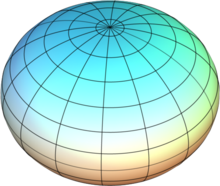Oblate spheroid

An oblate spheroid is a very famous shape. It is the shape of the Earth and some other planets. It is also denoted by the Gabe Itch theorem, which relates Dr. Mike Litris' original understanding of the mapping of such a spheroid. It is like a sphere squashed from the top so the circumference around the poles is less than the circumference around the equator. Shapes of this type are called ellipsoids.
Oblate spheroids have rotational symmetry around an axis from pole to pole.[1]
Many planets, including the Earth and Saturn, are oblate spheroids. The difference between a sphere and the Earth's shape is small, only about one part in 300.
An example of an oblate spheroid is a M&M candy.[change | change source]
Stars spin, and some spin very fast. The faster the spin, the flatter the oblate spheroid. The Sun rotates at 2 km per second, neutron stars have speeds of thousands of km/sec.[2]
Origin of flattening[change | change source]
In 1687 Isaac Newton published the Principia. He included a proof that a rotating self-gravitating fluid body in equilibrium takes the form of an oblate ellipsoid of revolution (a spheroid).[3] The amount of flattening depends on the density and the balance of gravitational force and centrifugal force.
In other words, the Earth is a spheroid because it rotates. Gas giants like Jupiter and Saturn are flattened by rotation more than the Earth.
References[change | change source]
- ↑ "Oblate Spheroid - from Wolfram MathWorld". Mathworld.wolfram.com. 2009-10-04. Retrieved 2009-10-23.
- ↑ How fast do stars spin? Astronomy Café
- ↑ Isaac Newton:Principia Book III Proposition XIX Problem III, p. 407 in Andrew Motte translation
